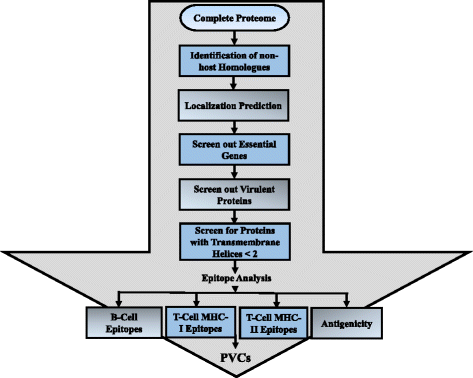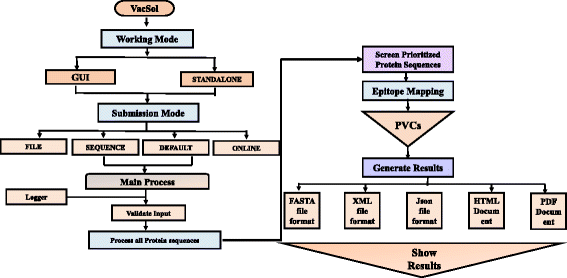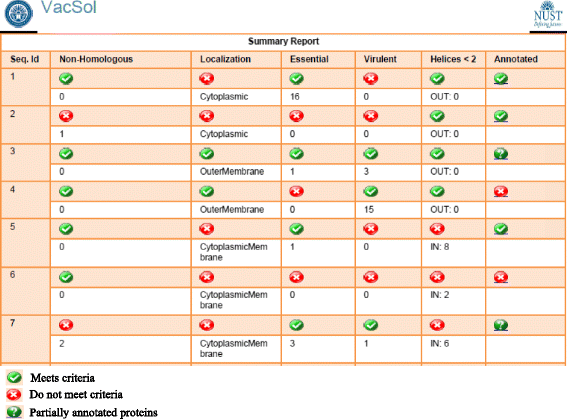VacSol: a high throughput in silico pipeline to predict potential therapeutic targets in prokaryotic pathogens using subtractive reverse vaccinology
- PMID: 28193166
- PMCID: PMC5307925
- DOI: 10.1186/s12859-017-1540-0
VacSol: a high throughput in silico pipeline to predict potential therapeutic targets in prokaryotic pathogens using subtractive reverse vaccinology
Abstract
Background: With advances in reverse vaccinology approaches, a progressive improvement has been observed in the prediction of putative vaccine candidates. Reverse vaccinology has changed the way of discovery and provides a mean to propose target identification in reduced time and labour. In this regard, high throughput genomic sequencing technologies and supporting bioinformatics tools have greatly facilitated the prompt analysis of pathogens, where various predicted candidates have been found effective against certain infections and diseases. A pipeline, VacSol, is designed here based on a similar approach to predict putative vaccine candidates both rapidly and efficiently.
Results: VacSol, a new pipeline introduced here, is a highly scalable, multi-mode, and configurable software designed to automate the high throughput in silico vaccine candidate prediction process for the identification of putative vaccine candidates against the proteome of bacterial pathogens. Vaccine candidates are screened using integrated, well-known and robust algorithms/tools for proteome analysis, and the results from the VacSol software are presented in five different formats by taking proteome sequence as input in FASTA file format. The utility of VacSol is tested and compared with published data and using the Helicobacter pylori 26695 reference strain as a benchmark.
Conclusion: VacSol rapidly and efficiently screens the whole bacterial pathogen proteome to identify a few predicted putative vaccine candidate proteins. This pipeline has the potential to save computational costs and time by efficiently reducing false positive candidate hits. VacSol results do not depend on any universal set of rules and may vary based on the provided input. It is freely available to download from: https://sourceforge.net/projects/vacsol/ .
Keywords: Computational pipeline; PVCs; Reverse vaccinology; Subtractive proteomics; VacSol; Vaccine candidates.
Figures



Similar articles
-
Comparison of Open-Source Reverse Vaccinology Programs for Bacterial Vaccine Antigen Discovery.Front Immunol. 2019 Feb 14;10:113. doi: 10.3389/fimmu.2019.00113. eCollection 2019. Front Immunol. 2019. PMID: 30837982 Free PMC article. Review.
-
Preliminary Work Towards Finding Proteins as Potential Vaccine Candidates for Vibrio cholerae Pakistani Isolates through Reverse Vaccinology.Medicina (Kaunas). 2019 May 23;55(5):195. doi: 10.3390/medicina55050195. Medicina (Kaunas). 2019. PMID: 31126058 Free PMC article.
-
Vacceed: a high-throughput in silico vaccine candidate discovery pipeline for eukaryotic pathogens based on reverse vaccinology.Bioinformatics. 2014 Aug 15;30(16):2381-3. doi: 10.1093/bioinformatics/btu300. Epub 2014 Apr 29. Bioinformatics. 2014. PMID: 24790156 Free PMC article.
-
ReVac: a reverse vaccinology computational pipeline for prioritization of prokaryotic protein vaccine candidates.BMC Genomics. 2019 Dec 16;20(1):981. doi: 10.1186/s12864-019-6195-y. BMC Genomics. 2019. PMID: 31842745 Free PMC article.
-
Developing vaccines in the era of genomics: a decade of reverse vaccinology.Clin Microbiol Infect. 2012 Oct;18 Suppl 5:109-16. doi: 10.1111/j.1469-0691.2012.03939.x. Epub 2012 Aug 6. Clin Microbiol Infect. 2012. PMID: 22882709 Review.
Cited by
-
Vaxign2: the second generation of the first Web-based vaccine design program using reverse vaccinology and machine learning.Nucleic Acids Res. 2021 Jul 2;49(W1):W671-W678. doi: 10.1093/nar/gkab279. Nucleic Acids Res. 2021. PMID: 34009334 Free PMC article.
-
Quantitative proteomics approach to investigate the antibacterial response of Helicobacter pylori to daphnetin, a traditional Chinese medicine monomer.RSC Adv. 2021 Jan 7;11(4):2185-2193. doi: 10.1039/d0ra06677j. eCollection 2021 Jan 6. RSC Adv. 2021. PMID: 35424199 Free PMC article.
-
Plant-Based Vaccines: Antigen Design, Diversity, and Strategies for High Level Production.Vaccines (Basel). 2022 Jan 10;10(1):100. doi: 10.3390/vaccines10010100. Vaccines (Basel). 2022. PMID: 35062761 Free PMC article. Review.
-
An In-Silico Investigation to Design a Multi-Epitopes Vaccine against Multi-Drug Resistant Hafnia alvei.Vaccines (Basel). 2022 Jul 15;10(7):1127. doi: 10.3390/vaccines10071127. Vaccines (Basel). 2022. PMID: 35891291 Free PMC article.
-
Engineering receptor-binding domain and heptad repeat domains towards the development of multi-epitopes oral vaccines against SARS-CoV-2 variants.PLoS One. 2024 Aug 15;19(8):e0306111. doi: 10.1371/journal.pone.0306111. eCollection 2024. PLoS One. 2024. PMID: 39146295 Free PMC article.
References
-
- Capecchi B, et al. The genome revolution in vaccine research. Curr Issues Mol Biol. 2004;6:17–28. - PubMed
MeSH terms
Substances
LinkOut - more resources
Full Text Sources
Other Literature Sources
Medical

